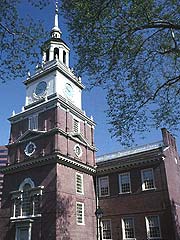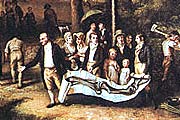Cultural Institutions
 |
| Charles Wilson Peale eventually moved his museum collection to Independence Hall, which still stands today. Image © 2002 www.clipart.com. |
As the largest city in the United States at the turn of the 19th century, Philadelphia boasted of growing cultural institutions. Not only did Independence Hall house a museum of natural history specimens, by 1805 the Pennsylvania Academy of the Fine Arts had been founded to display paintings and artwork of the time.
The man most identified with this growth was Charles Willson Peale. He was America's foremost portrait painter of the Federal period. It was his artistic center that became the academy, and it was his collection of specimens that became the Philadelphia Museum. In fact, the museum was often called Peale's Museum.
Peale himself was prolific in many ways. Twice widowed, he married three times, ultimately fathering 17 children, 5 of whom also became painters. Peale also provides the most widespread chronicle of the statesmen of the time. His most endearing subject was George Washington, whom he painted from life seven times. Together with two of his sons, Peale also painted more than 100 replica portraits of Washington.
Perhaps Peale's most lasting legacy is his art and natural history museum. In 1783 he displayed in his portrait gallery mammoth bones found in Kentucky. That exhibit inspired Peale and his sons to start their museum, which eventually moved to the more spacious Independence Hall in 1802. It contained nearly 250 paintings and thousands of specimens. The most exotic display was the gigantic mastodon skeleton that Peale reconstructed from a dig he led in New York in 1801. The framework of the skeleton was so large that Peale held a banquet with a table seating 12 held within the mammoth. A piano also fit within it.
The genial Peale believed that museums should be open to everyone, to educate and amuse people from all classes. He organized his collections according to scientific collection principles. He also solicited donations, developed an aggressive marketing campaign, started subscription memberships, and began the sale of museum souvenirs. He created the model that museums today still follow.
When Peale died in 1827, he was the patriarch of an important artistic family. Besides sons Raphaelle, Rembrandt, Rubens, and Titian II, who prospered both in art and museums, Peale also had nieces who emerged as some of the first female American painters.
< previous | next > | 




